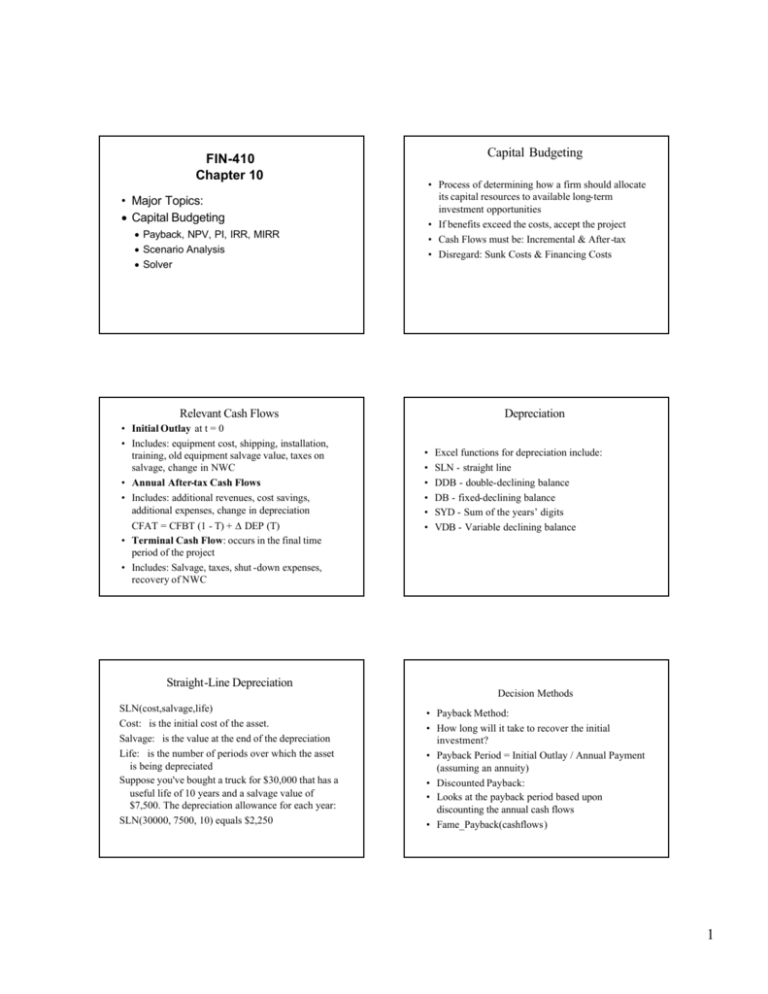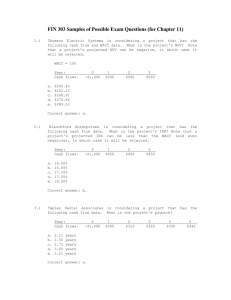FIN-410 Chapter 10 Capital Budgeting
advertisement

Capital Budgeting FIN-410 Chapter 10 • Process of determining how a firm should allocate its capital resources to available long-term investment opportunities • If benefits exceed the costs, accept the project • Cash Flows must be: Incremental & After-tax • Disregard: Sunk Costs & Financing Costs • Major Topics: • Capital Budgeting • Payback, NPV, PI, IRR, MIRR • Scenario Analysis • Solver Relevant Cash Flows • Initial Outlay at t = 0 • Includes: equipment cost, shipping, installation, training, old equipment salvage value, taxes on salvage, change in NWC • Annual After-tax Cash Flows • Includes: additional revenues, cost savings, additional expenses, change in depreciation CFAT = CFBT (1 - T) + ∆ DEP (T) • Terminal Cash Flow: occurs in the final time period of the project • Includes: Salvage, taxes, shut -down expenses, recovery of NWC Depreciation • • • • • • Excel functions for depreciation include: SLN - straight line DDB - double-declining balance DB - fixed-declining balance SYD - Sum of the years’ digits VDB - Variable declining balance Straight-Line Depreciation Decision Methods SLN(cost,salvage,life) Cost: is the initial cost of the asset. Salvage: is the value at the end of the depreciation Life: is the number of periods over which the asset is being depreciated Suppose you've bought a truck for $30,000 that has a useful life of 10 years and a salvage value of $7,500. The depreciation allowance for each year: SLN(30000, 7500, 10) equals $2,250 • Payback Method: • How long will it take to recover the initial investment? • Payback Period = Initial Outlay / Annual Payment (assuming an annuity) • Discounted Payback: • Looks at the payback period based upon discounting the annual cash flows • Fame_Payback(cashflows) 1 Net Present Value • NPV = Discounted value of the expected annual cash flows - initial investment • NPV Function: NPV(rate,value1,value2, ...) Rate: is the discount rate Value1, value2, ... are 1 to 29 arguments representing the payments and income. • Remember true NPV is NPV - initial investment • Decision rule? Profitability Index • Scaled present value • PI = PVCF / IO PVCF = present value of cash inflows IO = initial outflow Or PI = (NPV + IO) / IO • Decision rule? Internal Rate of Return • Measure of the average annual rate of return on the project • What rate equates the cash inflows to the cash outflows • IO = ∑ CFAT t / (1 + IRR) t • Decision rule? • Excel function: and solve for IRR • IRR(values,guess) IRR Problems • IRR & NPV may give different answers when considering Mutually Exclusive projects • If the projects are of greatly different sizes, if the timing or size of the cash flows are different, or if there is more than one change in sign of annual cash flows • Due to the reinvestment rate assumption. What rate does NPV and IRR assume the annual CF’s are reinvested? Modified Internal Rate of Return • MIRR(values,finance_rate,reinvest_rate) Finance_rate: is the interest rate you pay on the money used in the cash flows. Reinvest_rate: is the interest rate you receive on the cash flows as you reinvest them. NPV Profile Charts • Chart of NPV at various discount rates • Can determine how sensitive NPV is to the assumed discount rate. • Can also use to compare two mutually exclusive projects at various discount rates. NPV Profile 85 NPV (thousands) • MIRR is solved in the same way, but relates the initial investment with the future value of the annual cash flows, compounded at the required rate of return. • Then find the rate that equates the two values. • Excel function: 75 65 NPV 55 45 35 25 15 5 -5 0% 5% 10% 15% 20% 25% 30% 35% Required Return 2 Scenario Analysis Optimal Capital Budget Scenario Summary Current Values: Best Case Expected Case Worst Case Changing Cells: Maintenance Defects 5,000 2,000 2,000 1,000 5,000 2,000 8,000 5,000 Result Cells: Payback Period Discounted Payback Net Present Value (NPV) Profitability Index (PI) Internal Rate of Return (IRR) MIRR 2.58 3.53 27,552.24 1.44 30.95% 23.69% 2.33 3.08 36,401.93 1.58 35.85% 26.03% 2.58 3.53 27,552.24 1.44 30.95% 23.69% 3.09 4.25 14,277.70 1.23 23.41% 19.82% Capital Rationing • Under capital rationing, there is some constraint beyond funding all positive NPV projects. Perhaps limited capital, manpower, manufacturing facilities. • With a small number of projects you can simply rank the projects and eliminate the worst based on the limiting criteria. • With a larger number of projects you must use the computer to sort through the options • Calculate the IRR’s of all projects and rank from best to worst. • Plot the IRR’son the marginal WACC curve, from best to worst, using the cost of each project as the capital cost. This is the IOS. • Invest in all projects that have an IRR higher than the WACC. Marginal WACC Curve for RMM WACC (%) • Scenario Manager allows you to analyze the effects of different input assumptions. • For example, call up Tools, Scenario, and specify the best case, worst case, and expected case. • Specify the formulas to use in the scenario. • Finally, request a summary to calculate the values. 17.00% 16.00% 15.00% 14.00% 13.00% 12.00% 11.00% 10.00% 9.00% 8.00% 0 500,000 1,000,000 1,500,000 2,000,000 2,500,000 3,000,000 Total Capital WACC (%) IOS Solver • You can use Solver to choose the best projects. • Choose Tools, Solver, specify the Target Cell, whether to Max or Min, and then specify the constraints. • For the textbook example: This uses linear programming to maximize NPV, while, constraining cost to a maximum value and including each project 1 or 0 times. • Assignment: • • • Do all of the work in the chapter, final result should look like Exhibits 10-2,3,4,5,6 & 9 and all graphs on these exhibits. Include completed spreadsheets with all financial functions (PB, DPB, NPV, PI, IRR, MIRR). Format exactly like in the text. • Remember Columns/Rows/Gridlines Each person will turn in one set of information: print out of spreadsheet and print out of cell formulas Work is individual. • Due at the beginning of class • 3









